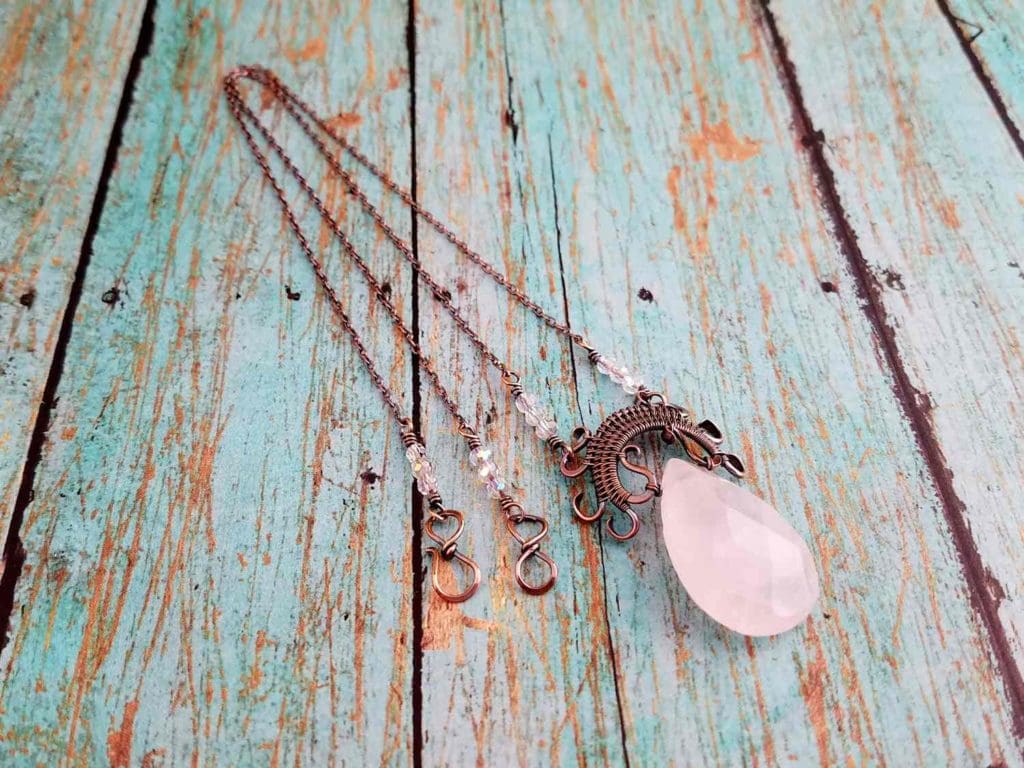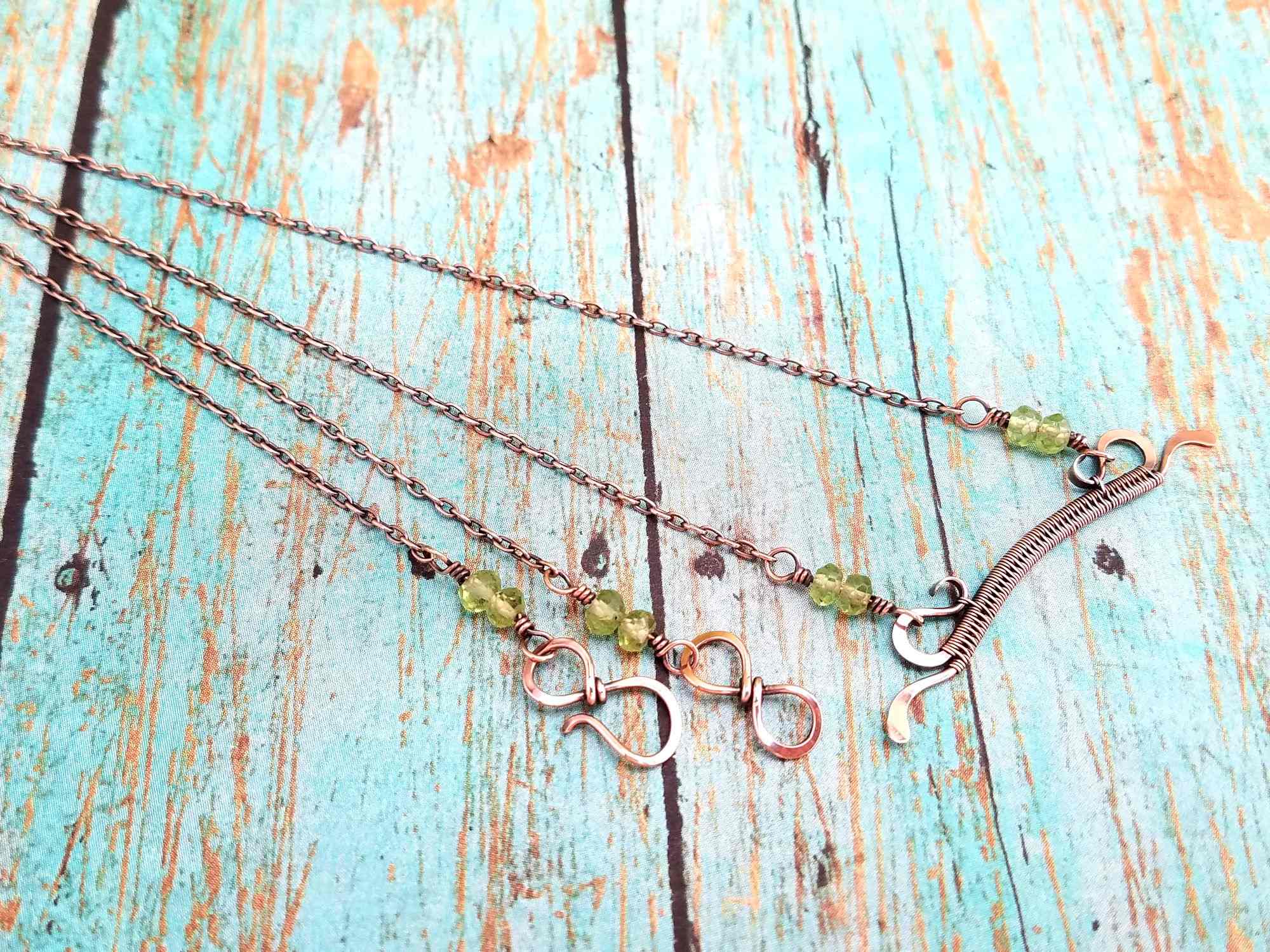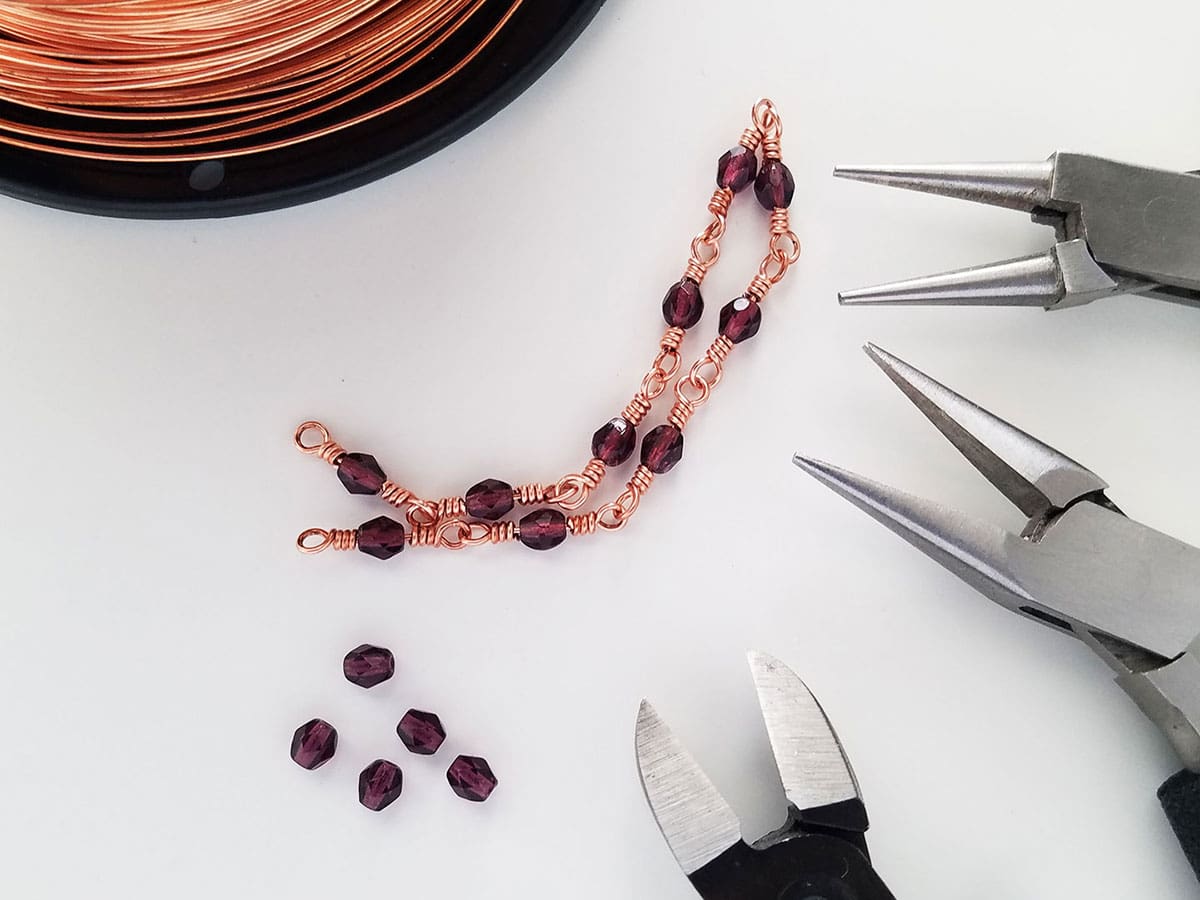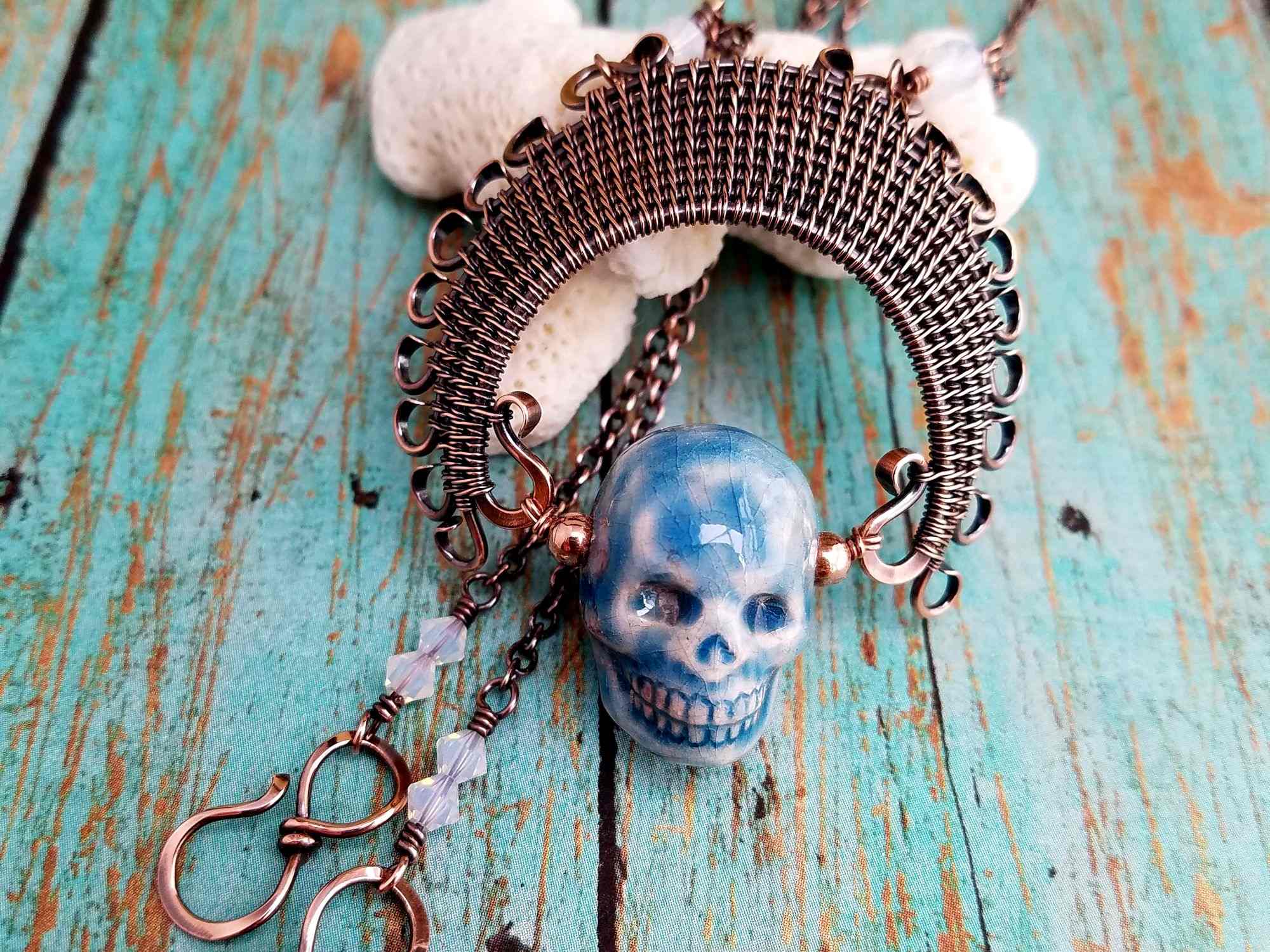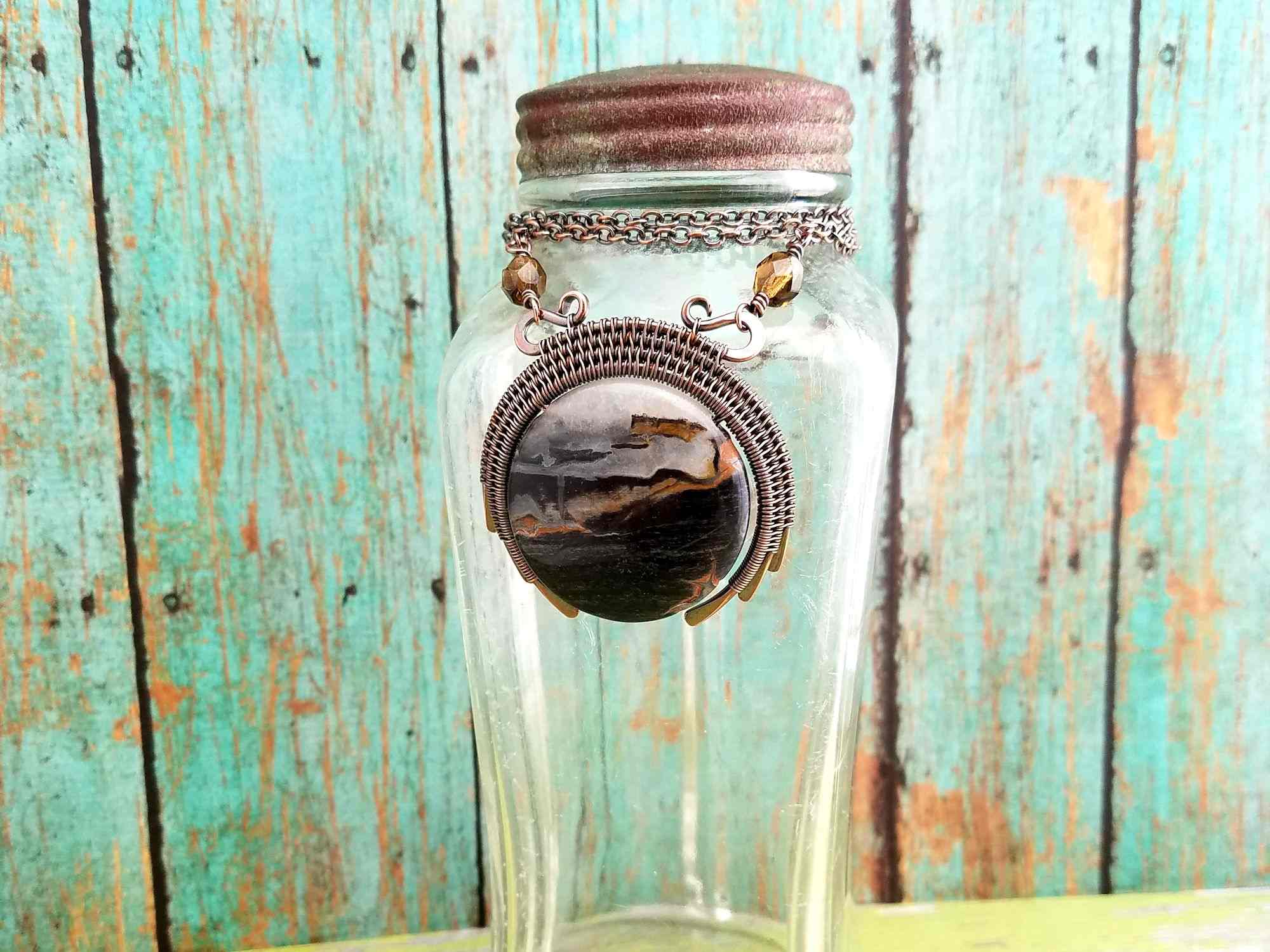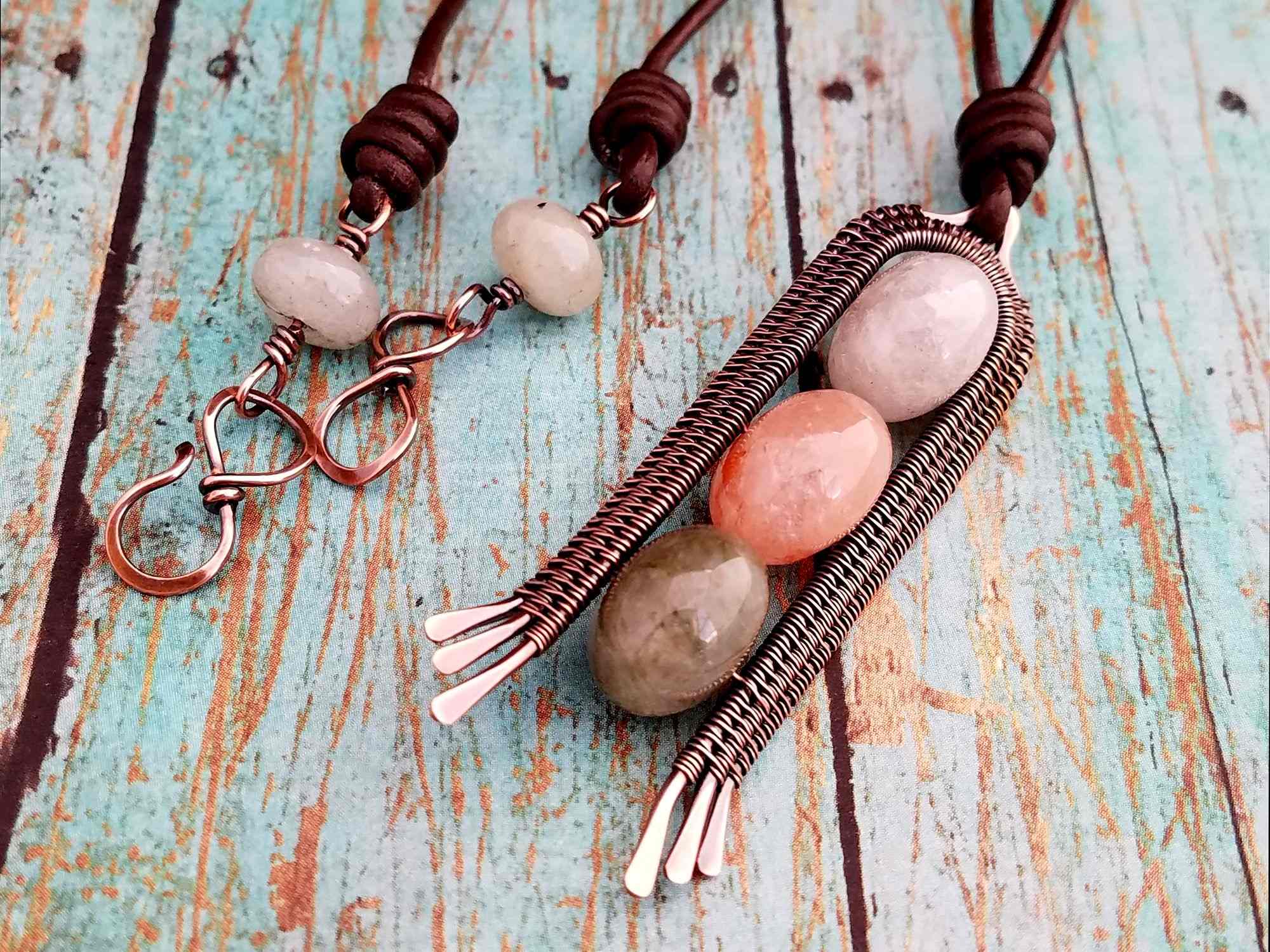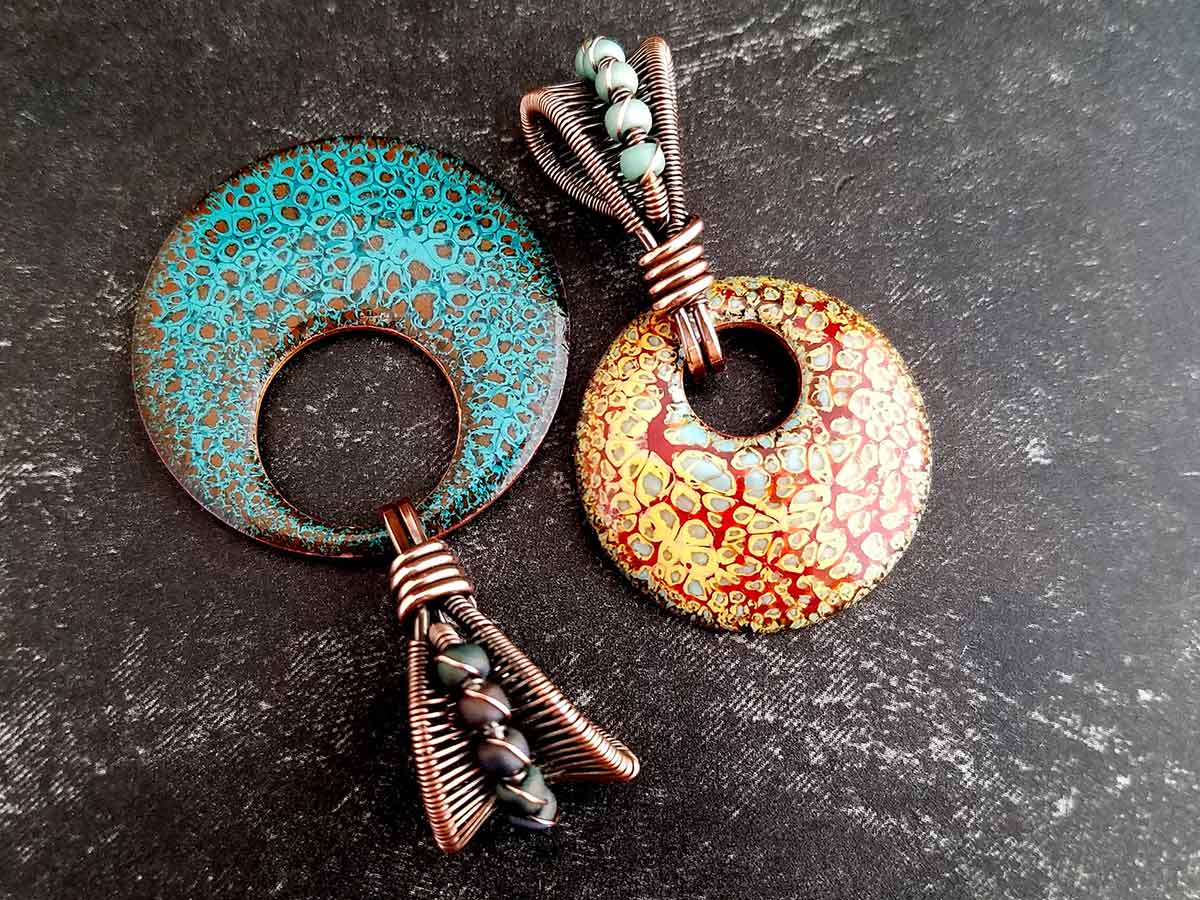How to Make the Pretty Little Lyonesse Pendant

The Lyonesse Pendant might be my favorite Door 44 jewelry design. I say that about a few of my designs, but this is the one I wear most frequently. And that really speaks for itself, doesn’t it? The things we reach for again and again are the things that we truly love.
The Lyonesse Pendant is pretty and feminine. And it’s also a super versatile design that scales easily up or down to work with almost any top-drilled focal bead. I enjoy creating this Door 44 jewelry design as much as I enjoy wearing it. And now you can make it, too!
The name comes from Arthurian legend. There’s something about the mystery of lost islands that fascinates me. And the sensuous curls of the wire woven bead frame make me think of waves closing in over a sinking island. So, I chose the name of the lost island of Lyonesse where King Arthur is said to rest.
I used a pretty 18mm x 28mm faceted Rose Quartz drop that I picked up at my local bead shop for this tutorial. This stone is just slightly larger than the 18mm x 24mm Amazonite drops I chose when I initially designed this bead frame.
You’ll find that the Lyonesse Pendant design adapts easily to almost any top-drilled drop bead, however, so don’t be afraid to experiment. There are so many interesting beads out there that I know you’ll want to create this necklace using different sizes and shapes. So, I’ve included recommendations for modifying the bead frame to fit nearly any bead that you choose. Look for those recommendations in the Variations section of this tutorial.
Copyright & Disclosure
You’re welcome to make and sell products from this tutorial. If you do so, however, please credit Door 44 Studios for the design and link back to this page.
When it comes to my written tutorials, on the other hand, I reserve exclusive rights to all images and written content. You may not reproduce or redistribute any portion of this tutorial in any way, shape, or form. Furthermore, you may not teach the designs contained within this tutorial without my written permission.
This copyright applies to the printable PDF version of this tutorial as well, and it’s included therein. You may share the free version of this tutorial only by linking directly to this page.
This post may contain affiliate links. If you click on a link and then make a purchase, I may earn a small commission (at no cost to you). As an Amazon Associate I earn from qualifying purchases. To learn more, please see my full disclaimer.
Want a printable version of this tutorial?
Getting Started
For best results, use solid copper or sterling silver wire for your core wires. Likewise, use dead soft copper or fine silver wire for weaving. If you use a filled wire, be aware that the bead frames are finished and hardened with a hammer. Even light hammering can expose the base metal core in filled wires, which can negatively affect your final finish. I don’t recommend plated or anodized craft wire for this necklace because those coatings will be ruined with this construction process. Refer to this post to learn more about jewelry wire and why I recommend solid wires for my tutorials.

Tools & Materials
- 18ga wire – 8 inches
- 20ga wire – 5 inches
- 22ga wire – 10 inches
- 26ga dead soft wire – 5 inches
- 30ga dead soft wire – 48 inches
- Top side-drilled teardrop focal bead – 1 each (I bought the Rose Quartz focal stone that I used at my local bead shop)
- 3mm to 6mm accent beads of your choice – 4+ each (these are the beads that I used)
- Copper or sterling silver necklace chain – 16 inches (this is the delicate copper chain that I used)
- Chain Nose Pliers
- Wire Cutters
- Stepped Bail-Making Pliers
- Nylon Jaw Pliers
- Needle File
- Chasing Hammer
- Bench Block
- Ring mandrel
- Ruler
- Fine Point Permanent Marker
- Sunshine® polishing cloths (optional). These are the polishing cloths that I use for dry polishing jewelry.
Finished Size
- WIDTH: about 1-1/8 inch (2.86 cm)
- LENGTH: about 1-3/4 inches (4.45 cm)
I added a delicate 18-inch chain embellished with 3mm crystal rondels to the sample pendant I made while writing this tutorial. I’ve included instructions for making the same chain that’s pictured here. Of course, you may customize the chain however you’d like.
You can easily adjust the length of your necklace by adding additional beads to the wrapped-loop connectors. Or simply change the length of the chain segments. Embellished chains are a great way to express your unique personality and style, so feel free to experiment.
Skill Level: Intermediate
This is a more challenging project that involves wire weaving. It can be achieved by someone who has some basic wirework skills.
This tutorial uses the Modified Soumak weave, and it requires using a chasing hammer. If you’re unfamiliar with either of these techniques, be sure to review those skill-based tutorials, which will help you work through this project successfully.
Other skills required are making wrapped loop connectors and working in closed spaces.
Instructions
These instructions assume that you’re using a flat teardrop focal bead, similar in size to the one pictured in this tutorial. However, the Lyonesse Pendant design can be easily adapted to any top side-drilled bead. I’ve listed my recommendations for resizing the bead frame to fit larger beads in the Variations section near the end of this tutorial. Be sure to refer to that section if you’ve chosen a focal bead that is substantially different than the Rose Quartz bead that I used. Otherwise, proceed with the instructions for the bead frame, as written.
The first thing we’re going to do is cut and shape the core wires that make up the bead frame.
Form the Core Wires
Step 1
Measure and cut four pieces of half-hard 18ga wire to the following lengths:
- 2 inches
- 1-3/4 inches
- 2 inches
- 2-1/4 inches
File the ends of the wires smooth, if necessary. Then mark the center point of each wire with your permanent marker.

Step 2
Use your bench block and chasing hammer to paddle the ends of all four wires. You want just a slight paddle on about 1/4 inch of each end of your four core wires. Then smooth and shape the paddles with your needle file until your four core wires look like those shown.
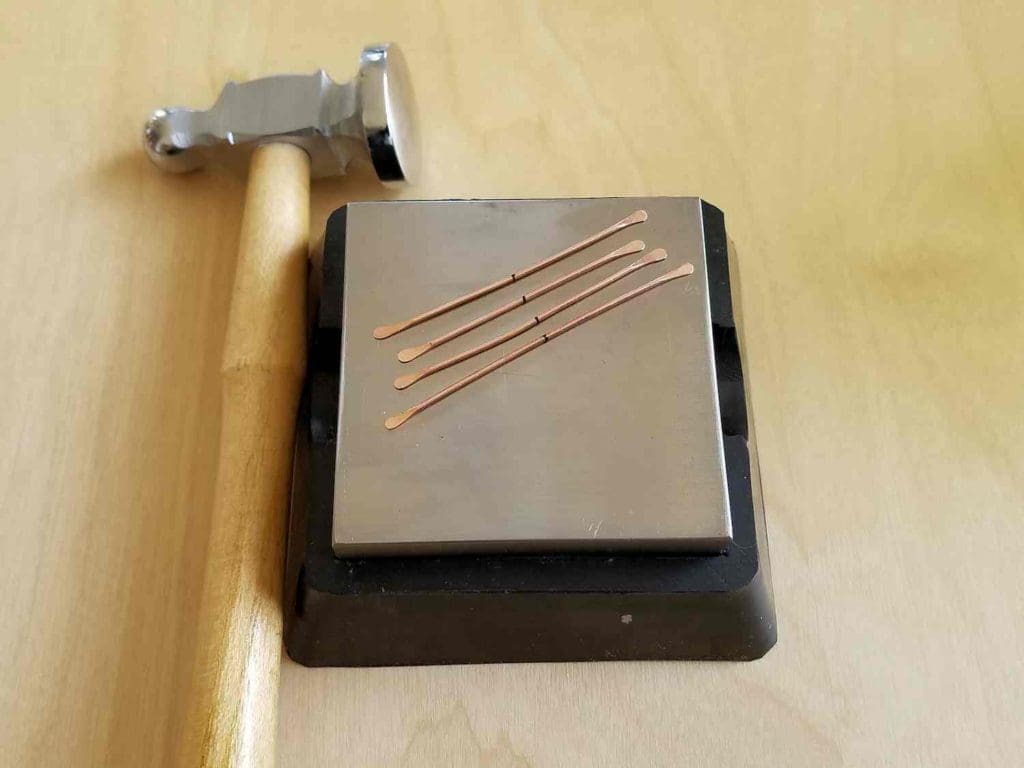
Step 3
We’re now going to shape the core wires, one at a time. Start with one of your 2-inch pieces of wire which we’ll call Wire 1.
Using the 2mm step (the smallest step) on your bail-making pliers, grasp the tip of one paddled end and gently curl it about 3/4 of the way around the mandrel.
Repeat on the other end making sure that the two curls face one another, as shown.
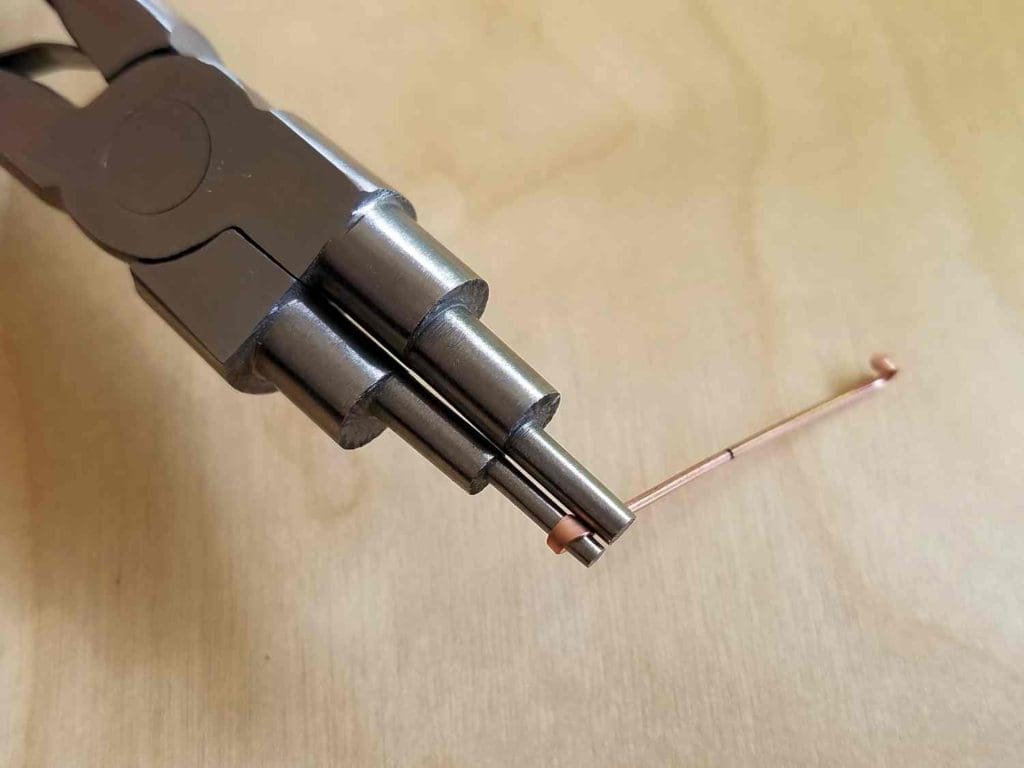
Step 4
Take the same wire you just shaped in Step 3 (Wire 1) and position one curled end of the wire at the center of the 3mm step (the second step) of your bail-making pliers. Grasp the wire just under the tight curl you made in Step 3. The rounded face of the curl should be pointing toward you.
Use your fingers to push the long end of the wire away from you and bring it all the way around the 3mm mandrel until the small curl made in Step 3 touches the straight length of the wire, as shown.
Repeat on the other end to complete your shape and set that wire aside for now.
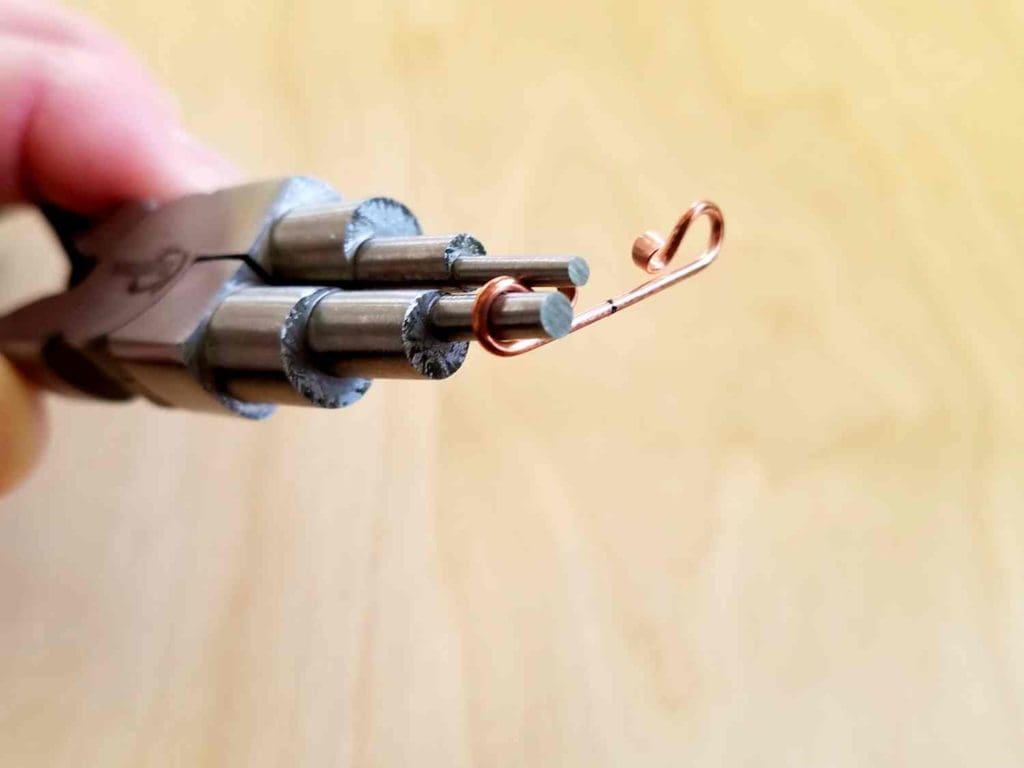
Step 5
Wire 2 is the 1-3/4-inch piece. Use the 3mm step (the second step) of your bail-making pliers to curl each end of that wire.
As in Step 2, grasp the wire at the very tip of the paddle and gently curl it about 3/4 of the way around the 3mm mandrel.
Repeat on the other end making sure that your two curls face one another, as shown. Then set wire 2 aside.

Step 6
Wire 3 is the remaining 2-inch piece. Use the 3mm step (the second step) of your bail-making pliers to curl each end of the wire as described in Step 5.
Make sure that the two curls face one another, as shown, and set Wire 3 aside for now.
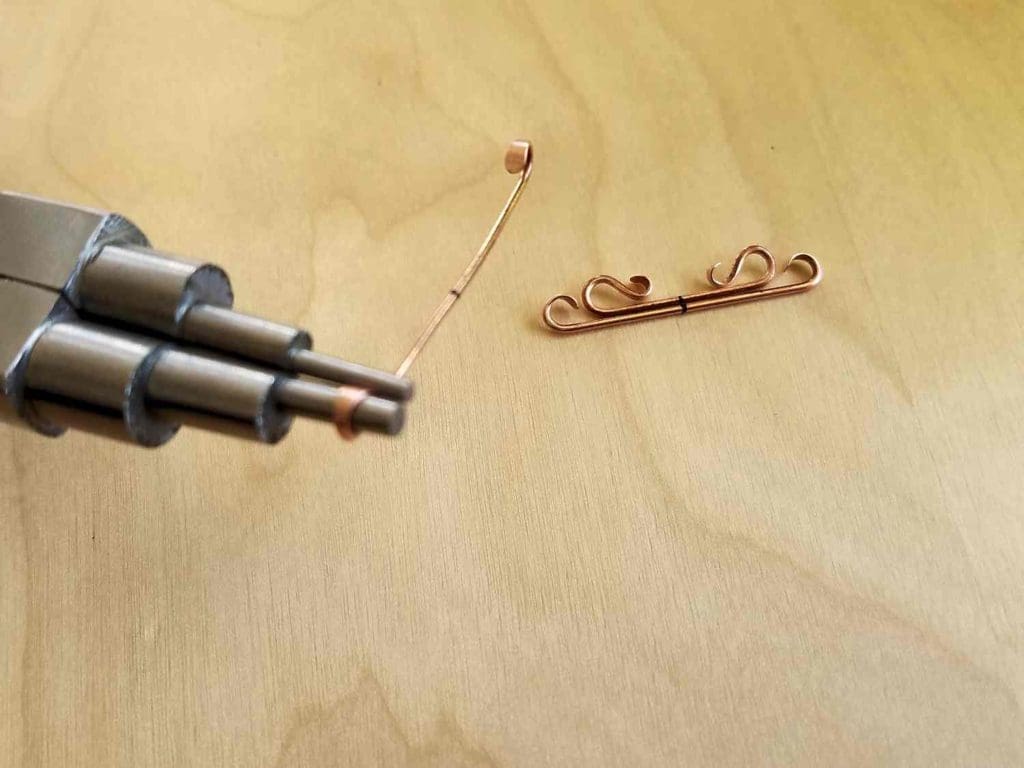
Step 7
You should have one piece of wire left at this point – the 2-1/4-inch piece, which is Wire 4.
Using the 2mm step (the smallest step) of your bail-making pliers, curl the paddled ends of the wire as you did for the other three core wires.
Make sure the two curls face one another, as shown.
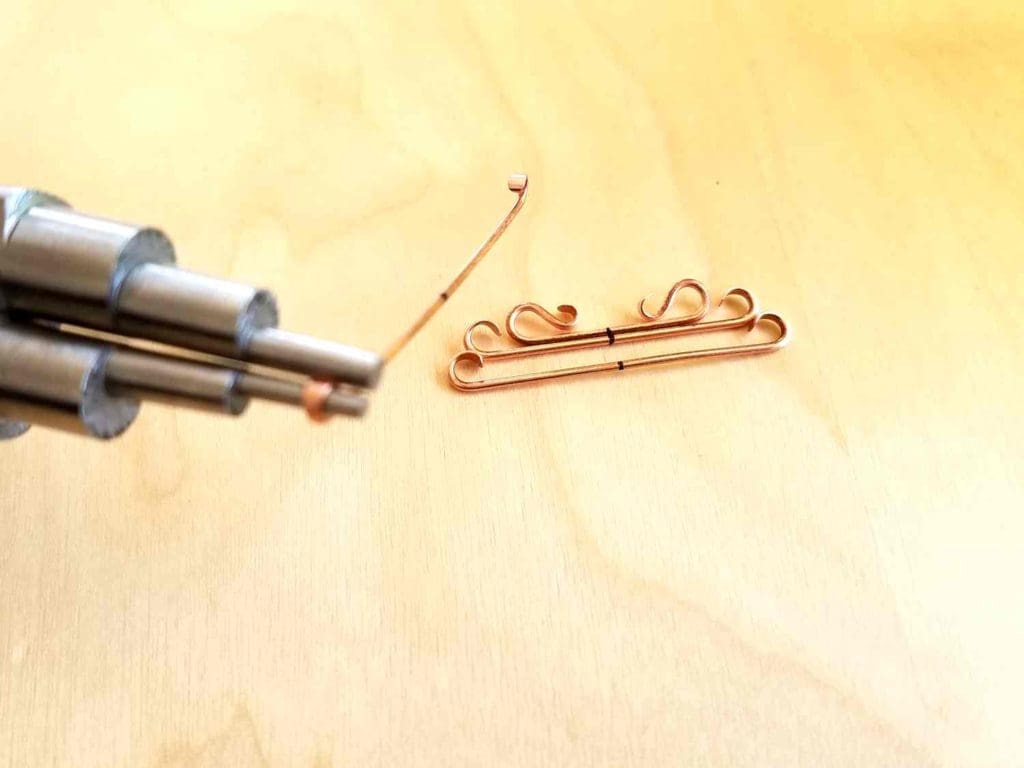
Step 8
Now we’re going to form the core wires into nested curves, starting with Wire 4, which is the innermost core wire of the bead frame.
Position the center mark of Wire 4 at the 1-3/4 ring size on your ring mandrel. Make sure the curls are facing up (away from the surface of the mandrel). Then gently form the wire almost all the way around the ring mandrel.
This wire is long enough that the ends will meet on the back side of the mandrel. That’s okay. Don’t force the ends to cross or to wrap completely around the mandrel. Instead, create a smooth curve that forms a symmetrical teardrop shape, as shown.
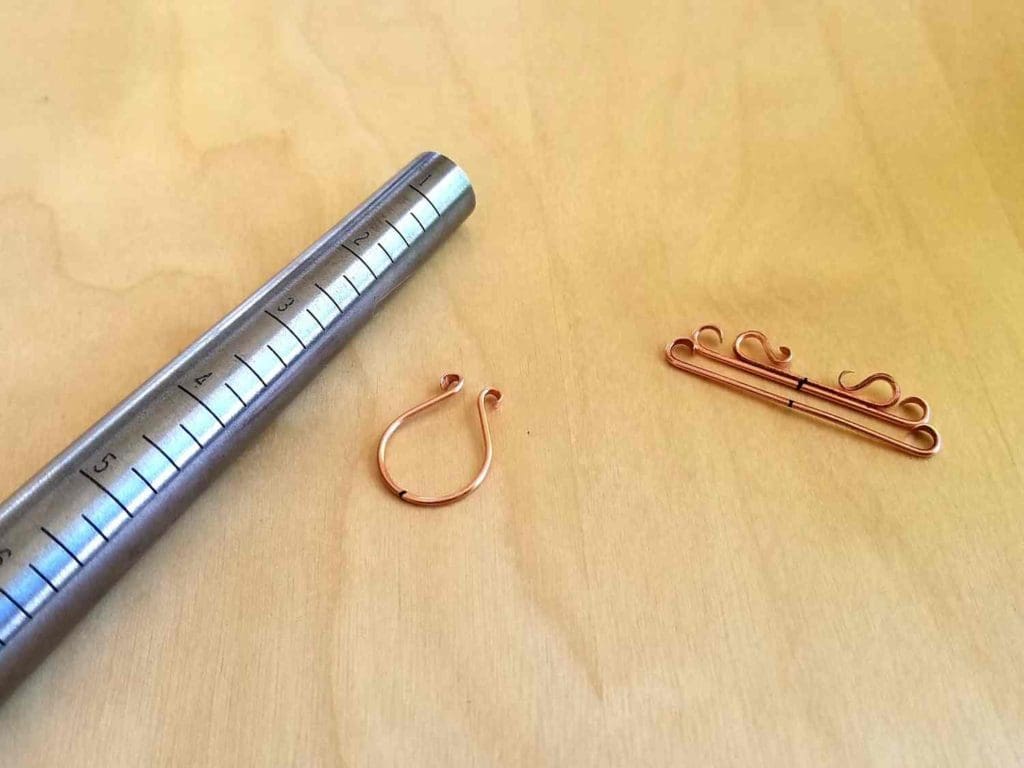
Step 9
Take the same wire you just formed in Step 8 (Wire 4) and position one curled end of the wire at the center of the 3mm step (the second step) of your bail-making pliers. Grasp the wire just under the tight curl you made in Step 7. The rounded face of the curl should be pointing toward you.
Use your fingers to curl the wire around the 3mm mandrel toward the inner curve of the wire. Bring it all the way around the 3mm mandrel until the small curl made in Step 3 touches the curved length of the wire, as shown.
Repeat on the other end to complete your shape and set that wire aside for now.
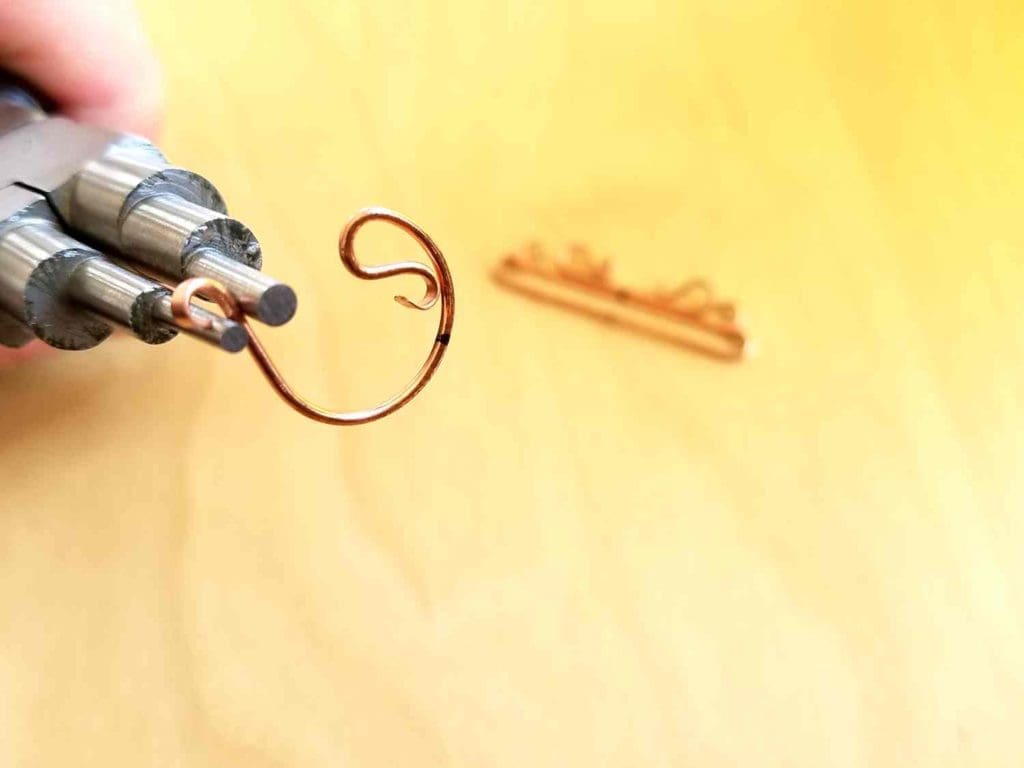
Step 10
Pick up Wire 3, which is the longest remaining core wire to be formed. Position the center mark of the wire at the 4-3/4 ring size on your ring mandrel.
Make sure the curls on your core wire are facing up. Then use your fingers to gently mold the wire around the ring mandrel as far as you can without stretching the curled ends out of shape.
Wire 3 should now nest neatly above Wire 4.
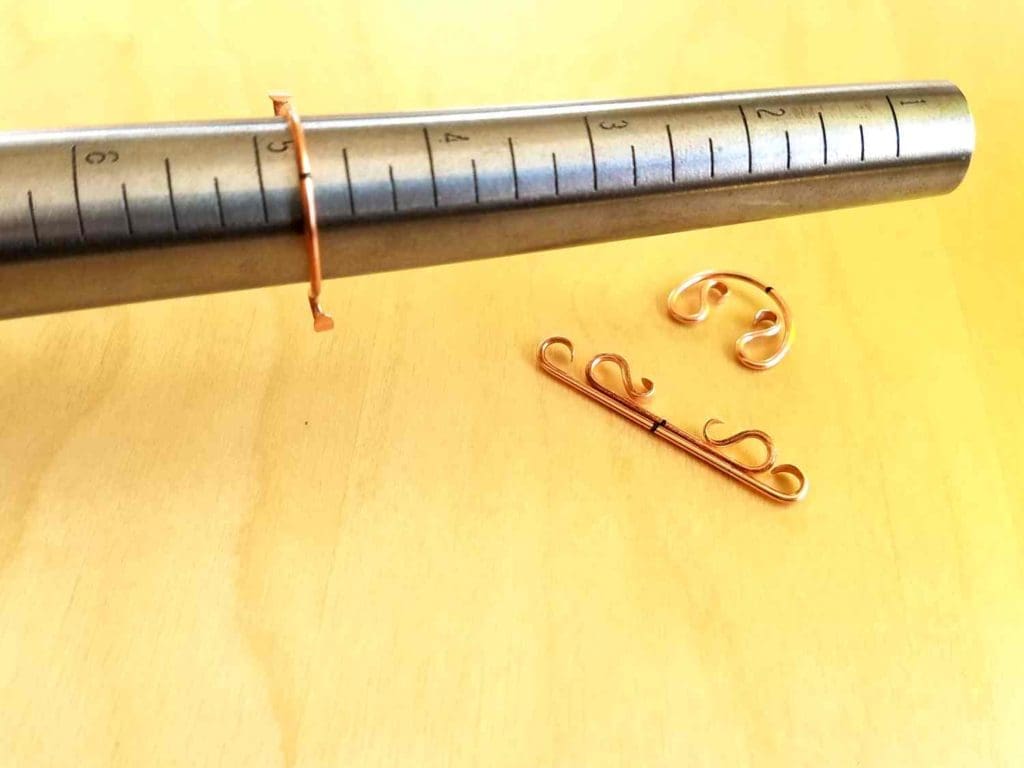
Step 11
Form Wire 2 the same way you just formed Wire 3 in Step 10, only position the wire at the 7-3/4 ring size on your ring mandrel.
Remember to make sure the curls are facing up (away from the mandrel). Also, be sure to center the wire on the mandrel so your curve is smooth and symmetrical.
Wire 2 should now nest neatly above Wire 3.

Step 12
Wire 1 is formed the same way as Wires 2 and 3. Position the wire at the 10-3/4 ring size on your ring mandrel.
Make sure that the formed ends of the wire are perpendicular to the surface of the ring mandrel. Then use your fingers to gently mold the wire into a curve around the mandrel as far as it will go without stretching the formed ends of the wire.
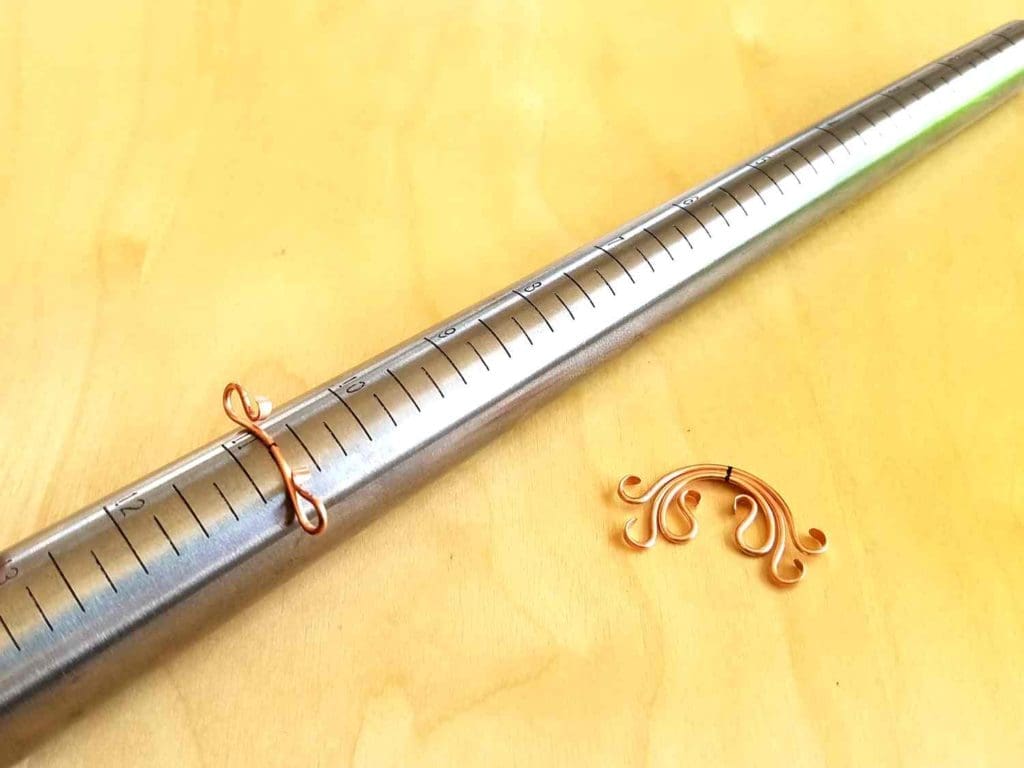
Step 13
Now that all your core wires are fully formed, we need to harden the ends of Wires 1 and 4 so they’ll retain their shape.
Use your bench block and chasing hammer to carefully flatten the curved ends of each wire, but be careful to avoid hitting the small curls with your hammer.
If hammering the curved ends opens a gap between the small curls and the core wire, gently squeeze the gap closed with the 2mm step of your bail-making pliers. We’re going to lash those ends to the core wire in the next section of this tutorial. So, don’t worry if you can’t close that gap completely.

Your frame wires are now complete and ready to weave together. Before proceeding, nest all your core wires together and line up the center marks.
The wires should nest neatly together, and everything should be lined up symmetrically. If not, make any necessary adjustments now. Mark new centerlines on your core wires, if necessary.
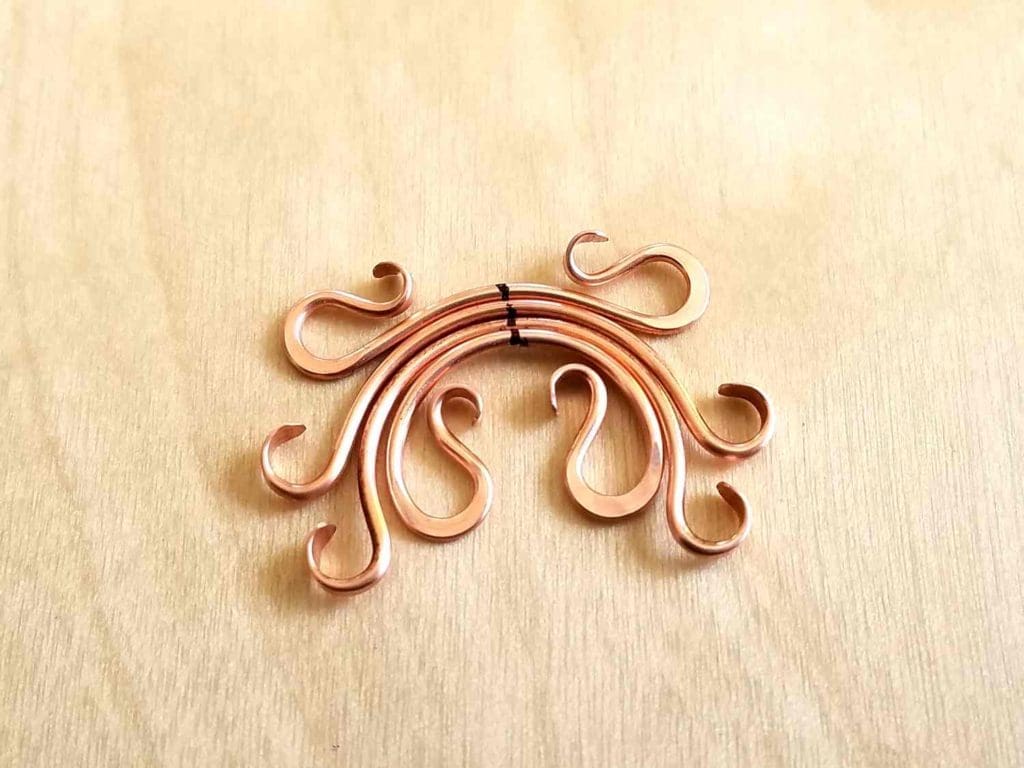
Weave the Core Wires Together
Step 1
Cut a 48-inch length of dead soft 30ga wire.
Note: If you’re making a silver pendant, you should have used half-hard sterling silver for the core wires. Use dead soft fine silver wire for weaving in this section.
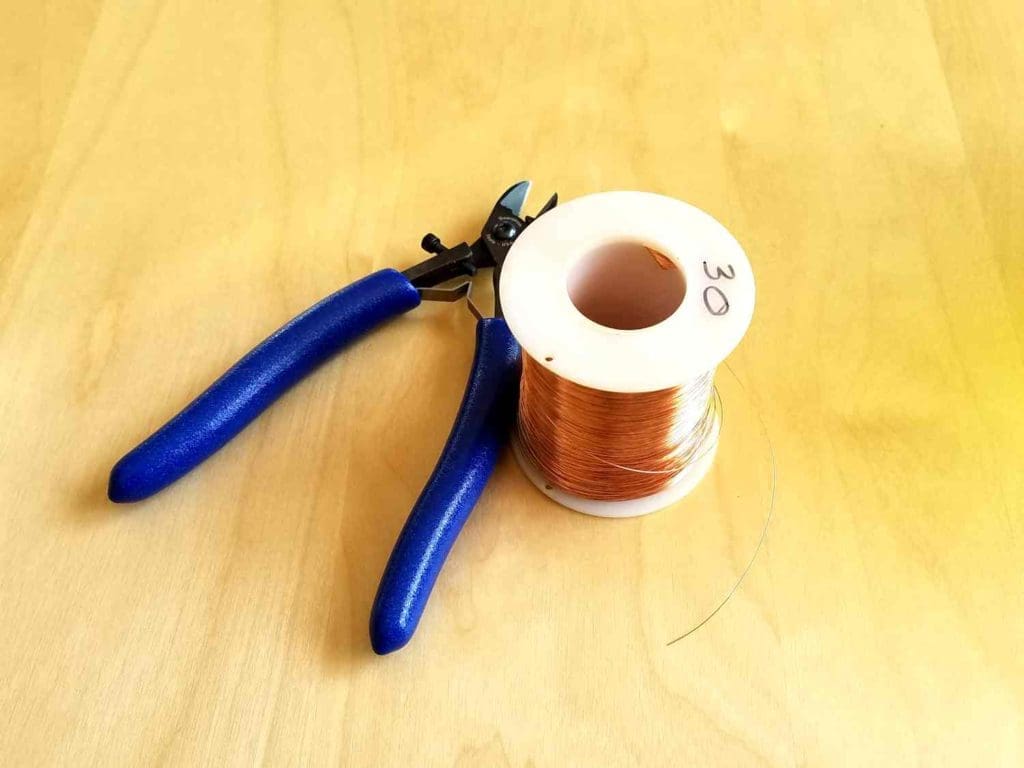
Step 2
Locate the center of your 48-inch weaving wire and position it at the center marks on your core wires. Begin weaving the four core wires together using the Modified Soumak weave.
Weave in one direction until you reach the small curl on Wire 1. Make sure your center lines are still aligned properly before securing that curl. If not, slide the wires back into position. Then lash the small curl of Wire 1 with a single pattern repeat.
Continue weaving in pattern until you reach the small curl on Wire 4. Again, check the alignment of your core wires. Adjust as needed. Then lash the small curl of Wire 4 with a single pattern repeat.
Continue weaving in pattern until you have 3 or 4 pattern repeats within the large loop of Wire 1. Then reduce your weaving pattern to Wires 2 through 4. When you reach the curl on Wire 2, reduce your weaving pattern again to Wires 3 and 4.
Continue weaving in pattern until you reach the point where Wires 3 and 4 diverge. Finish off your weave with three wraps around Wire 3. Break your weaving wire.
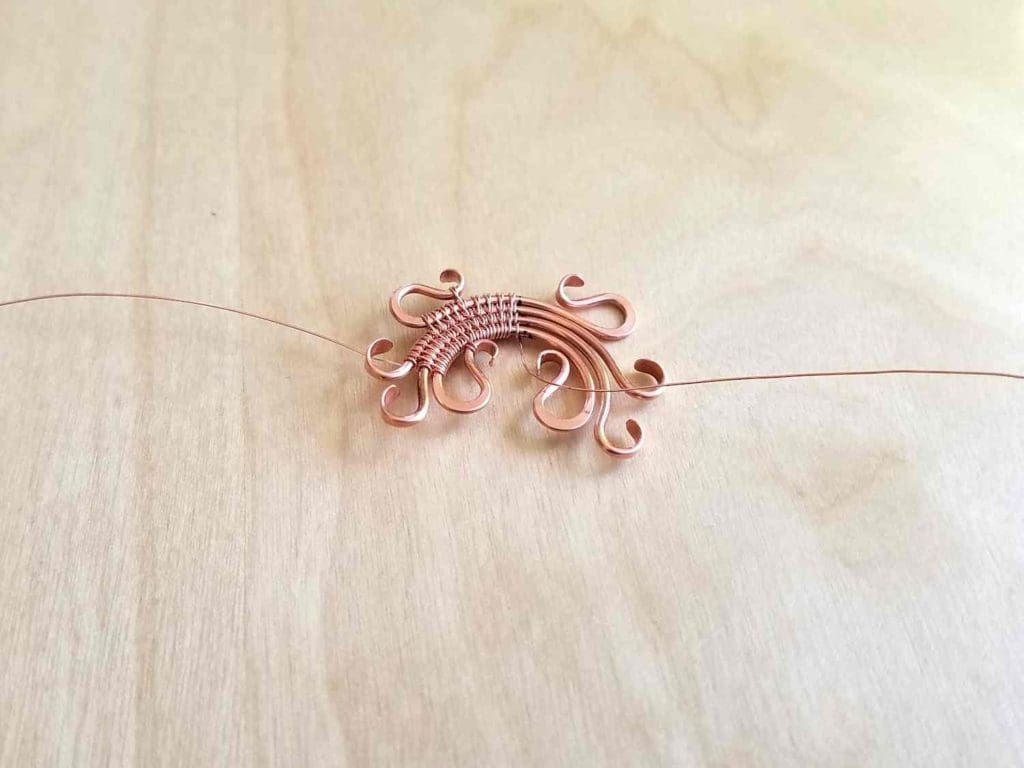
Step 3
Flip your bead frame over and repeat Steps 1 and 2 on the other side of the frame.
Again, make sure your core wires are all aligned on the center marks. You won’t be able to adjust Wires 1 and 4 at this point. Once you lash the small curls on those wires, they’re pretty much locked in place, but you can still slide Wires 2 and 3, if necessary.
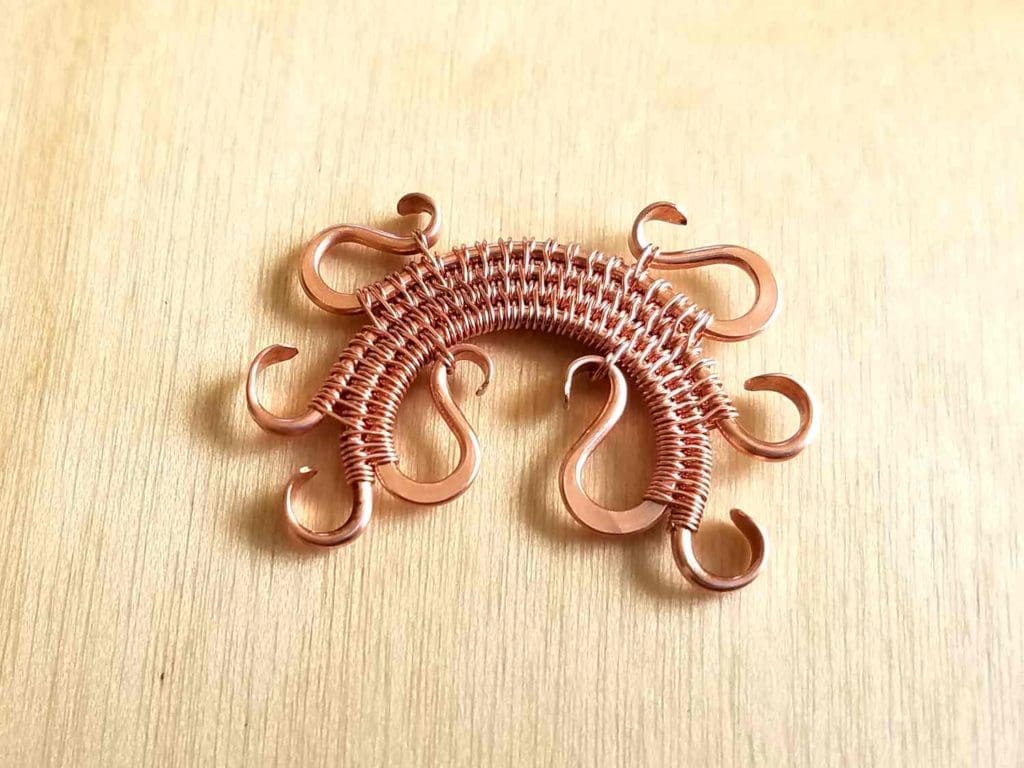
Step 4
Now that the weaving is complete, we’re going to form your bead frame into a pretty shape that will add dimension to your focal piece.
Use your fingers to gently push the bead frame into a convex curve. Then use your fingers or your chain nose pliers to gently bend the curled ends of the core wires back. Those ends should continue along the lines of the convex curve.
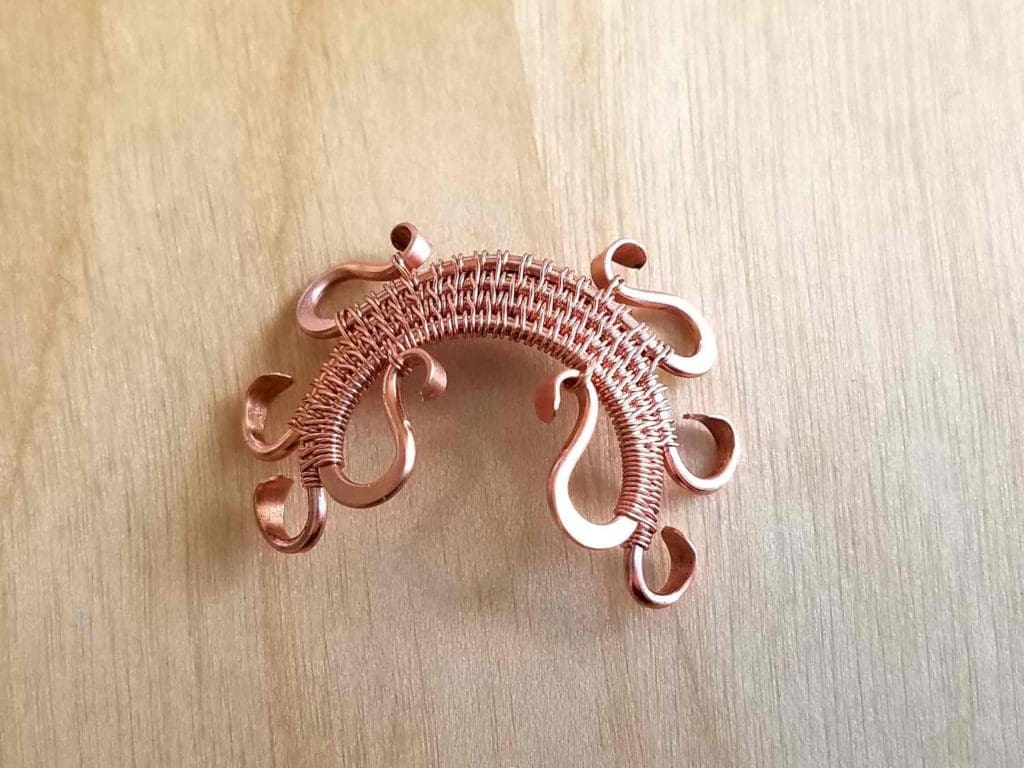
Secure the Focal Bead
Step 1
Cut a piece of 26ga dead soft wire 5 inches long. This is the wire you’ll use to secure your focal bead to your woven bead frame.
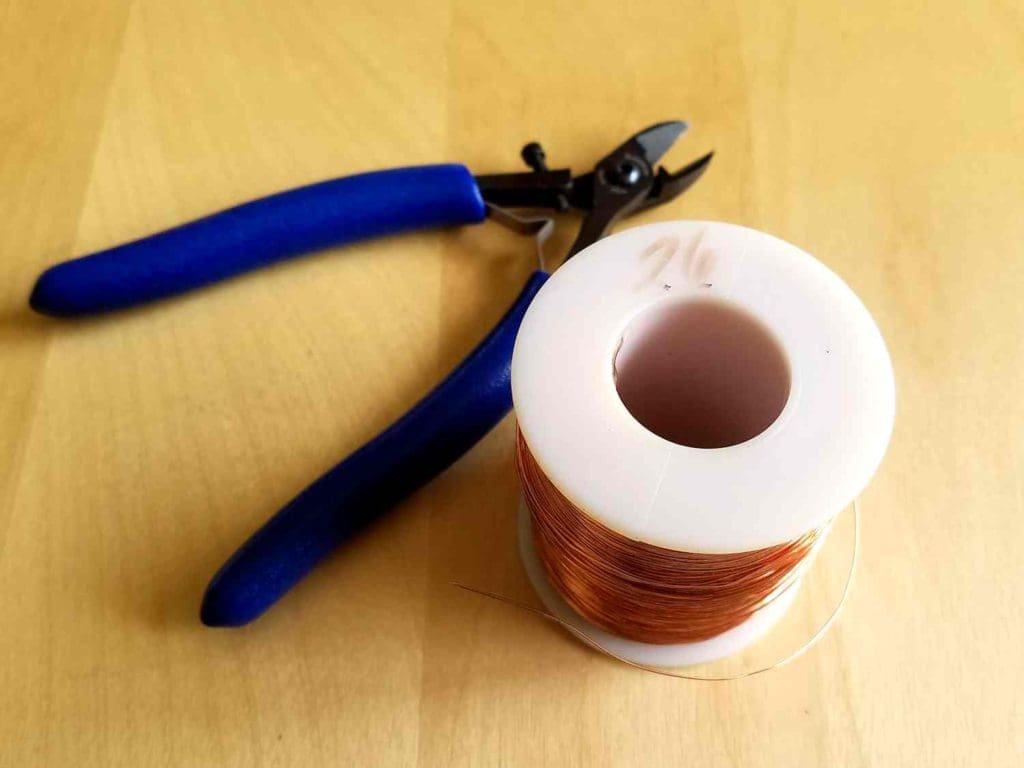
Step 2
Make sure the bead fits comfortably between the two large loops on Wire 4. If the fit is tight, gently spread the bead frame open until the point of the bead fits comfortably within the frame. The hole on your bead should line up with the large loops.
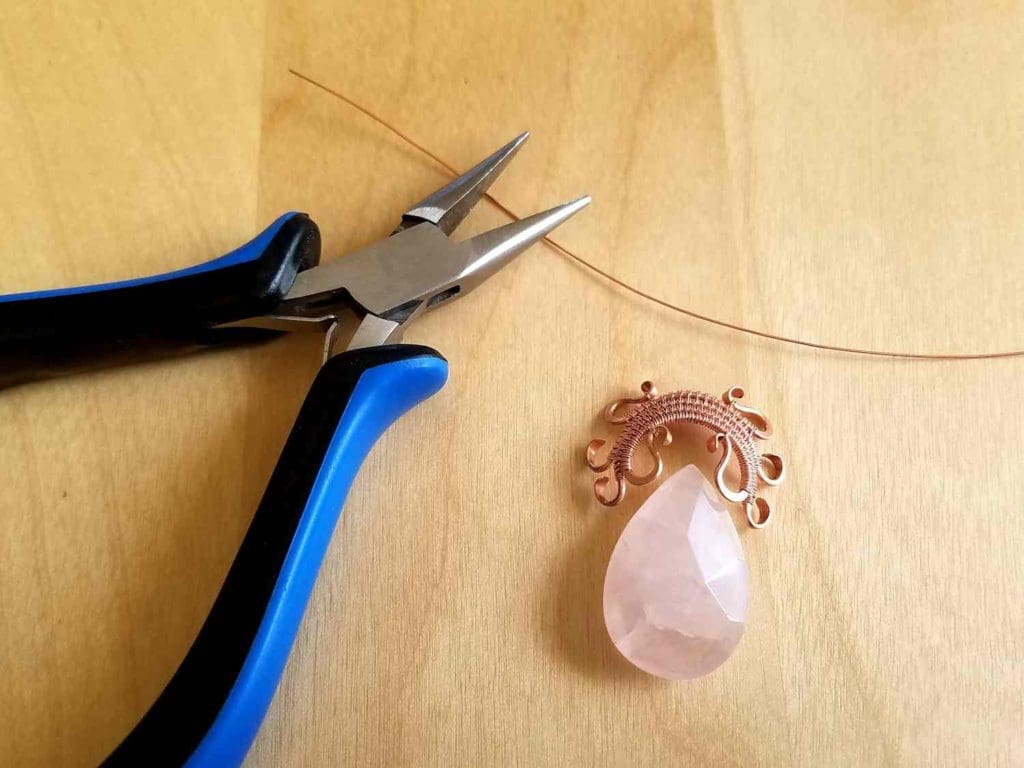
Step 3
Take one end of your 26ga wire. At about 2 inches from that end, wrap the wire twice around one large loop on Wire 4. Make sure the wraps are close together. Then feed the long end of the wire through your bead.
Bring that end of the wire up through the other large loop on Wire 4, from back to front. Tug it gently until your focal bead slides up into position between the two wire loops. Then wrap the long end of the wire twice around the wire loop.
You should now have two wraps around the wire loops on either side of your bead. You should also have one loose end of the wire on either side of your bead.
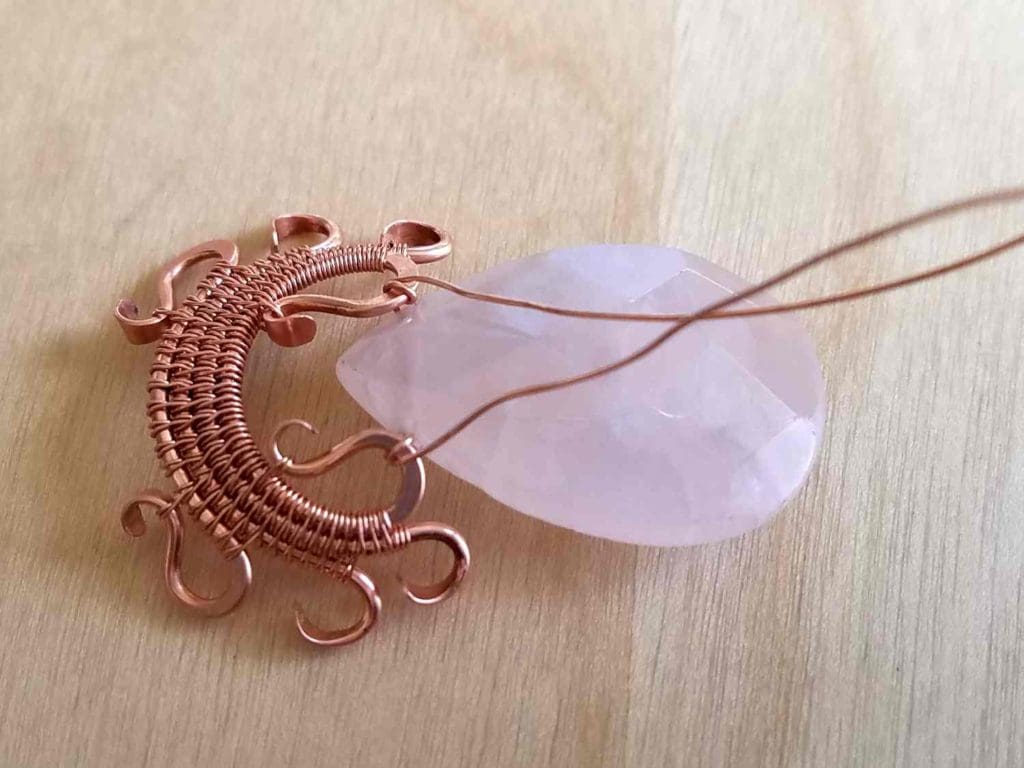
Step 4
Take one loose end of the wire and wrap it twice around the wire passing through your bead. These wraps will be between the wire loop and your bead. Pull the wraps tight and break your wire on the back side of your pendant.
Repeat on the other side of the bead with the remaining wire tail.

Your pretty Lyonesse Pendant is now complete. You can finish it with a chain of your own choice. Or proceed to the next section where I’ll walk you through the process of making the 18-inch chain I used on my necklace.
Assemble the Chain
Step 1
Cut two pieces of chain 8 inches long.
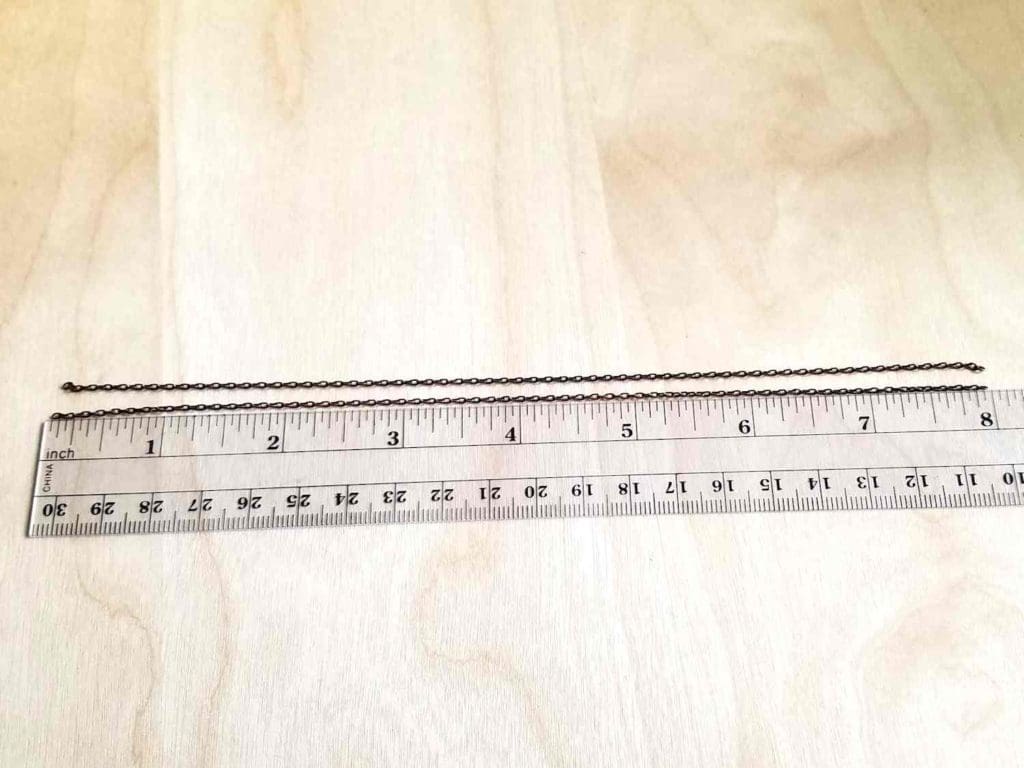
NOTE: the chain pictured here is from a spool that I pre-finished. If you purchase this same chain, which is specified in the Resources section of this tutorial, be aware that it comes with a bright copper finish. I’m confident that this chain can handle the second round of patina and tumble. So, I went ahead and secured it to the wrapped loop links for illustration purposes.
If you’re using a prefinished chain, however (especially one that you bought at a craft store), I don’t recommend tumbling the chain. Instead, hold off on attaching the chain until after your pendant, clasp, and wrapped loops are finished and polished. Leave the four loops that attach to the chain open until after you’ve finished and polished your wire components. Then attach the chain and close the loops.
Step 2
Cut four pieces of 22ga half-hard wire 2-1/2 inches long. Then mark each wire at 1 inch from one end. This is where you’ll begin your wrapped loops.

Step 3
Begin a wrapped loop and thread it through one of the large loops at the top of your pendant. Then finish wrapping the loop.
Repeat on the other side of the frame. We’re now going to work on one half of the chain at a time.

Step 4
Thread one or more accent beads onto one of the wrapped loops you just added to the top of your pendant. I used three 3mm crystal rondels on my loops. Then begin a second wrapped loop just above the bead(s) and thread one end of your chain onto the loop. Now close the loop with the same number of wraps that you used on the other side of the connector.

Step 5
Begin another wrapped loop and thread it onto the other end of the chain you just connected to your pendant. Finish wrapping that loop. Then thread your accent beads onto the wrapped loop and begin a second wrapped loop just above the beads. That end will connect to one side of your clasp.
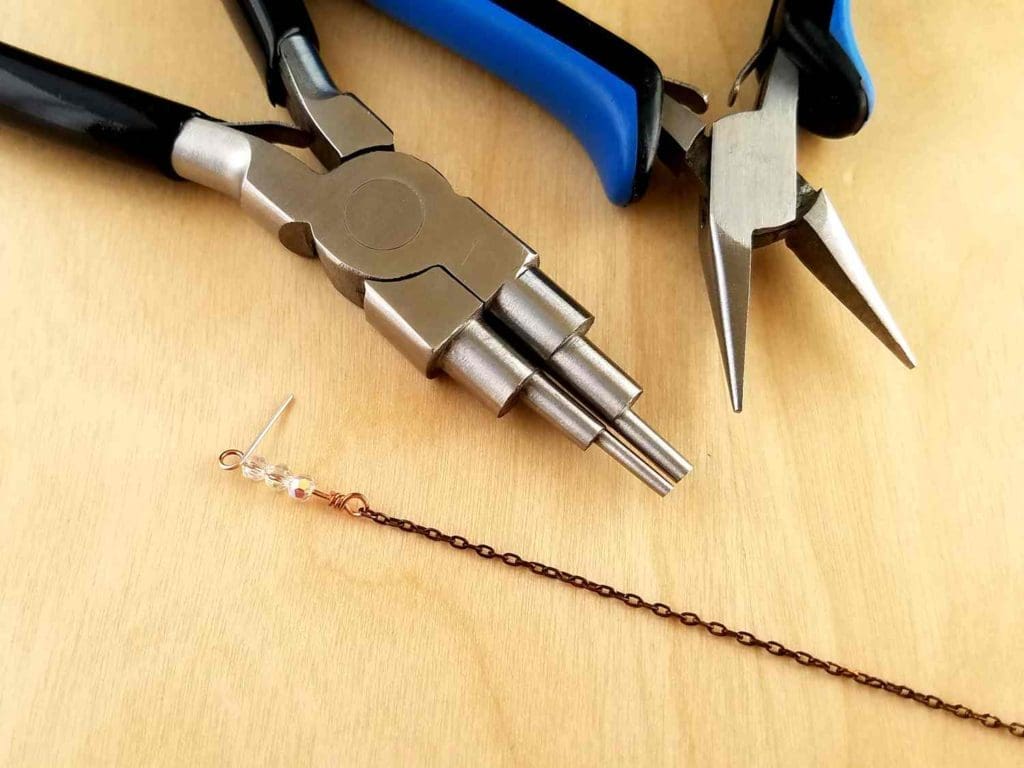
Step 6
Repeat Steps 4 and 5 on the other side of your Lyonesse Pendant using the two remaining pieces of 22ga wire and the remaining section of chain.
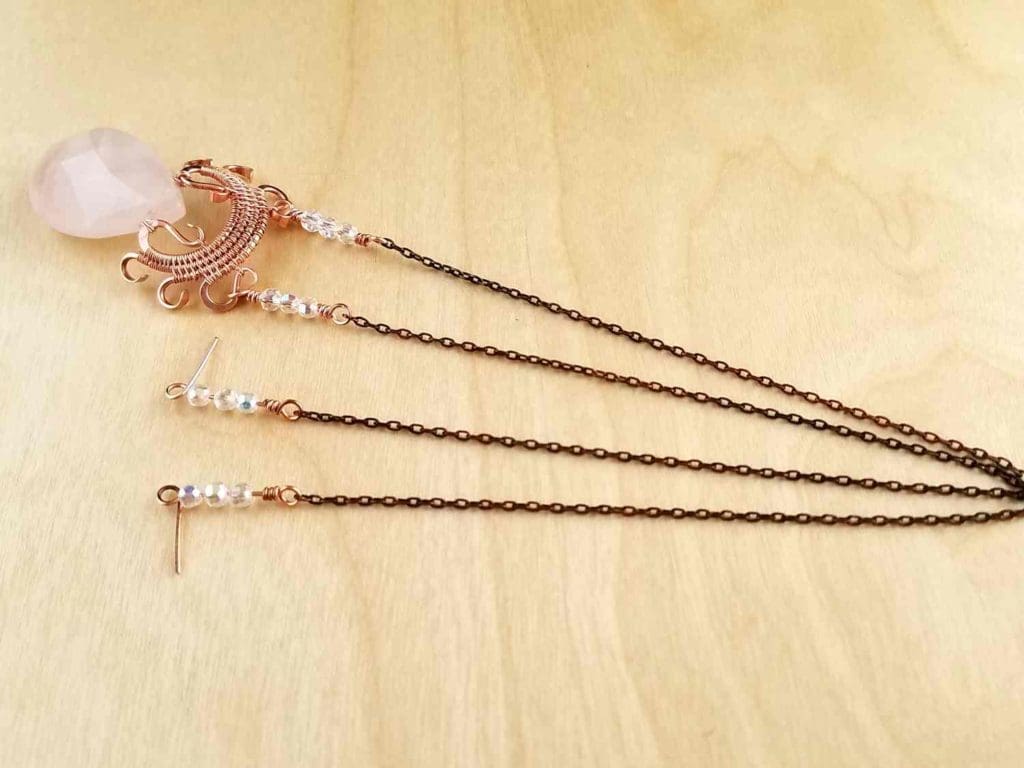
Step 7
Using 5 inches of 20ga half-hard wire, make a small Infinity Clasp. Then connect one half of the clasp to each of your remaining open loops. You can find a downloadable PDF tutorial for my Easy Infinity Clasp here, or check out the free version of that tutorial here.
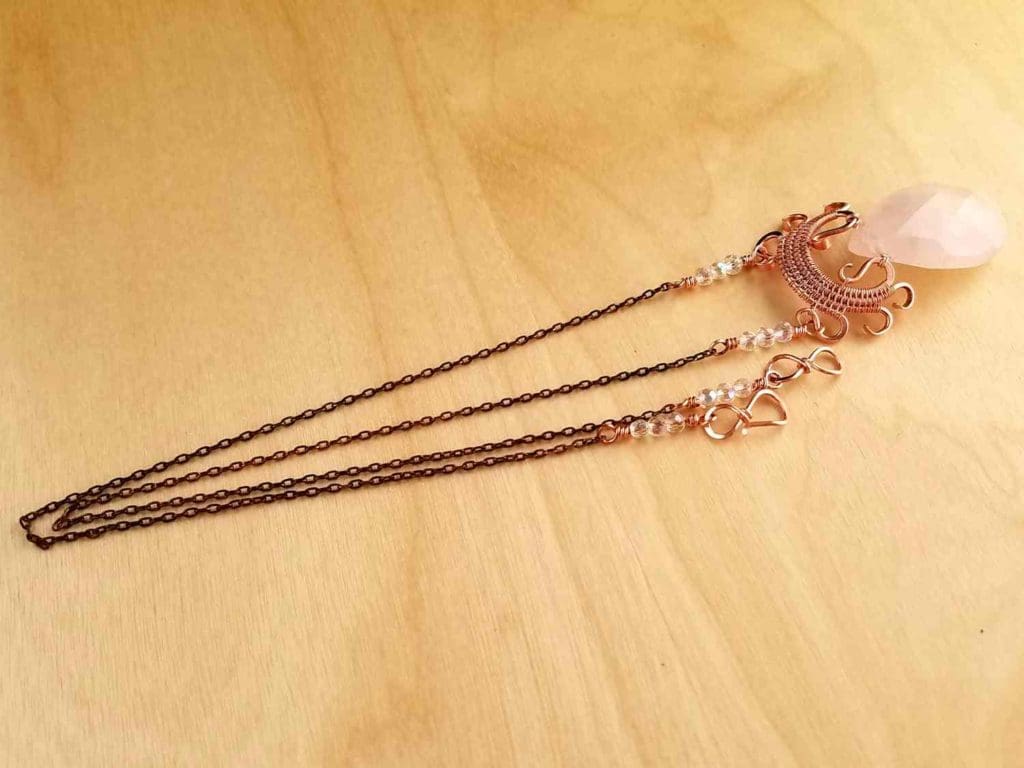
That’s it. You’ve just completed your Lyonesse Pendant! Now, put it on and admire your work. It’s a good idea to wear new pieces for a few hours to make sure they’re comfortable. Look for sharp points that might irritate skin or snag clothing. Then make any final adjustments before giving your new necklace it’s final finish and polish.
Want a printable version of this tutorial?
Finishing Your Lyonesse Pendant
I patina all my copper and silver jewelry with Liver of Sulfur (LOS) first. Then I polish my jewelry with a rotary tumbler. If you want to know exactly what that process looks like, be sure to read my free 7-Step Finishing Process tutorial. Also, if you’d like to learn more about why I recommend tumble polishing specifically, check out this post.
Before tumbling stones or delicate beads, I recommend sacrificing a test bead. Run a test tumble to make sure that your beads won’t be damaged in that process. I don’t recommend tumbling natural pearls, certain soft gemstones or glass beads with polymer coatings, such as glass pearls and certain frosted-look beads.
If you do choose to use these types of beads, tumble all the wire components of your jewelry (including the wire you plan to use to attach your beads) prior to weaving in the beads. That way you can achieve a beautiful antiqued metal finish without damaging your delicate beads.
Variations of the Lyonesse Pendant
The bead frame for the Lyonesse Pendant can be adapted to virtually any type of top side-drilled bead, including drops, raw crystals, oblong pendants, and spears. As a matter of fact, all of the necklaces shown below are variations of the Lyonesse Pendant design.

Modifying the Lyonesse Bead Frame
In order to modify this frame to fit other types of beads, first, consider the size of the focal bead that you have in mind. You want the size of your bead frame to balance with the size of your bead.
You can accommodate larger focal beads in two different ways. Firstly, use heavier gauge core and weaving wires to make a larger frame, as I did on the oblong Rainbow Agate pendant shown above (far right). Secondly, add more core wires, as I did for the raw crystal point and the Ancestor Pendant above (far left and center).
In fact, the Ancestor Pendant is such a popular variation of the Lyonesse design that I created a separate tutorial exclusively for that design. As always, that tutorial includes links to my favorite source for skull beads. Click the image below to check out the free version of that tutorial or click here for the ad-free printable PDF tutorial.
Want the Ancestor Pendant Tutorial?
Key Points to Consider Before Modifying the Lyonesse Pendant Design
The key points you need to keep in mind as you expand this design to fit various focal beads are the width of the bead at the point where the hole is drilled and the overall look that you’re trying to achieve.
Do you want the focal stone to be the most prominent feature of your pendant, as with the oblong Rainbow Agate pendant shown here? Or, do you want the bead frame to be a major feature of the pendant, as in the wire woven headdress on the Ancestor Pendant?
In either case, you’ll need to adjust the length (and possibly the gauge) of your core wires to accommodate the larger beads. The Rainbow Agate pendant frame, for instance, was made with 16ga core wires and 28ga weaving wire. Also, you can add spacer beads, as I did on the Ancestor Pendant, to help the focal bead stand out.
Don’t Be Afraid to Experiment with This Design
Choose three different styles and sizes of focal beads. Then see what sort of results you get by changing the core wire gauge or the number of core wires. The principles for forming and weaving the core wires remain the same. You simply need to change the cut lengths of your core wires to change the size of your bead frame. You may also need to adjust the size of the mandrels that you use to shape the core wires.
When determining the lengths of your core wires, form the inner core wire (the one that attaches to the bead) first. Once you’ve refined that piece, step each additional core wire down by 1/4 to 1/2 inch until you reach the final core wire, which will attach to your chain. That wire needs to be between 1/4 and 1/2 inches longer than your last core wire.
Finally, if you plan to repeat your modified Lyonesse Pendant design, keep good notes on the ideal lengths for your core wires.
Discover More Behind Door 44
Thanks so much for joining me today. I hope you enjoyed creating my pretty little Lyonesse Pendant. If you’d like a printable PDF version of this tutorial, you can find it here.
Want more free wire jewelry goodness?
I like to share useful wire weaving tips and tricks on my social media channels, and we have some great conversations about wire jewelry in my private Facebook Group. Also, be sure to connect with me @door44studios on Instagram, and Facebook to keep up with everything that’s happening behind Door 44. And if you haven’t already done so, be sure to subscribe to my YouTube channel where you’ll find new wire jewelry videos weekly.
Until next time, go make something beautiful!

Pin This Tutorial for Later



